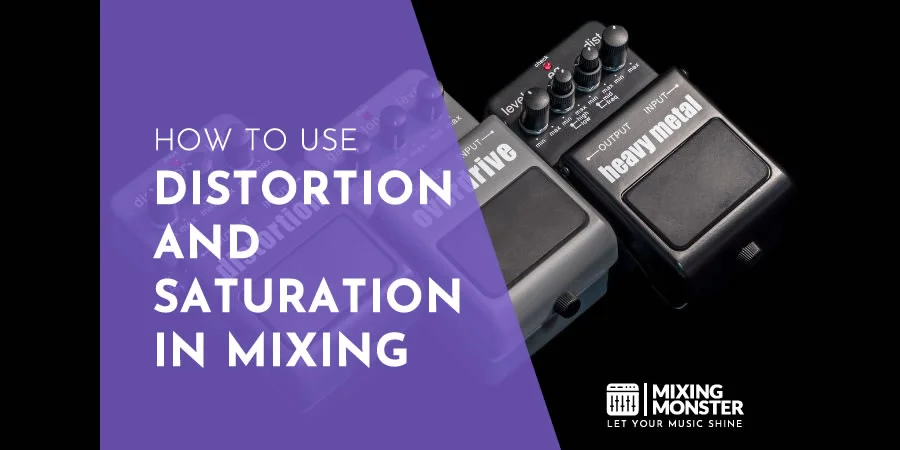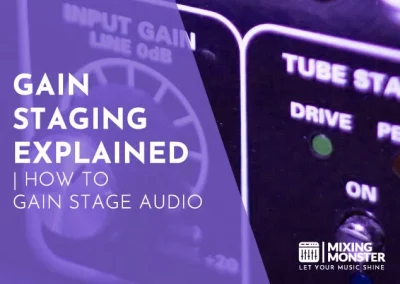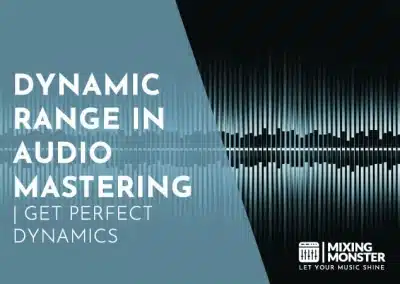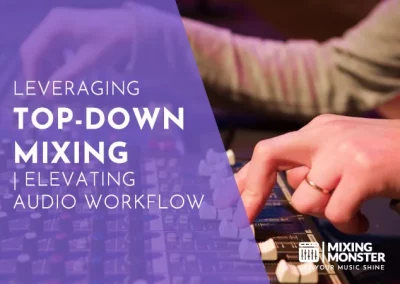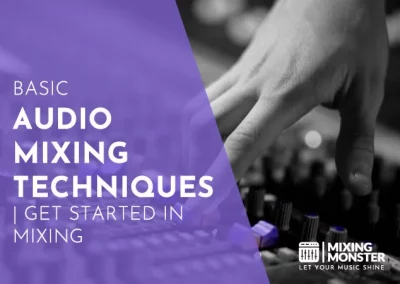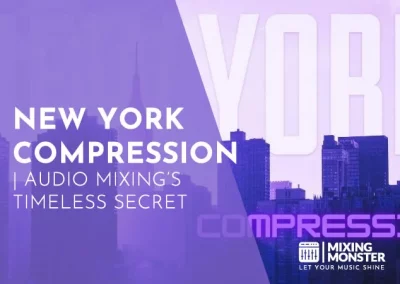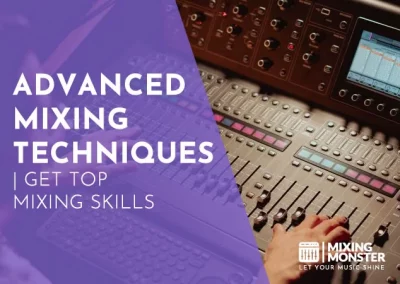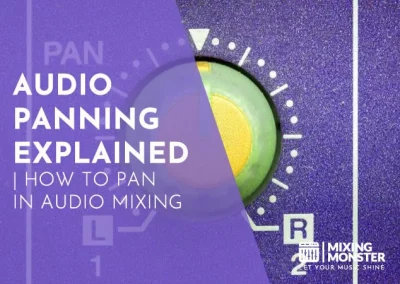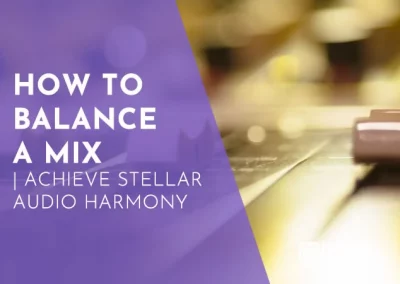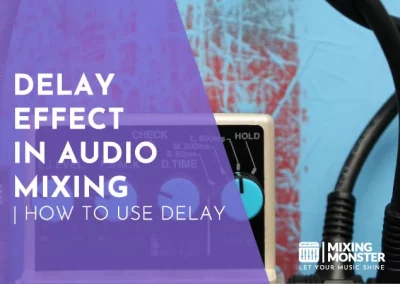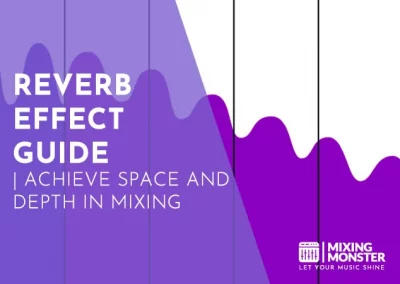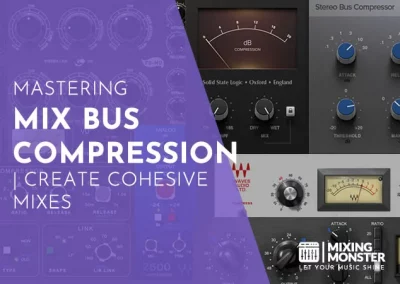Home > Blog > Mixing > Mixing Techniques
Disclosure: Some of the links below are affiliate links, meaning that at no additional cost to you, we will receive a commission if you click through and make a purchase. Read our full affiliate disclosure here.
Distortion in mixing is a powerful tool that, when used effectively, can significantly enhance the sonic character of a track. It’s not just about making things ‘louder’ or more abrasive—it’s about texture and color. Producers and engineers can responsibly apply distortion to an audio signal to add richness, depth, and energy to their mixes.
The use of distortion and saturation in mixing has become a sophisticated art form. Distortion, when skillfully applied, serves not merely to increase loudness but to impart texture and tonal color, enhancing the overall sonic quality of a track. There are various types of distortion, such as tube, tape saturation, and digital bit crushing, each contributing unique characteristics.
However, it’s crucial to strike the right balance when applying distortion, as too much of it can lead to a muddy mix or even unintended noise that detracts from the clarity of your track. Learning the different types of distortion and their characteristics can greatly inform your mixing decisions. Knowing when to use each type can help you apply distortion to other elements in your mix, whether you want to add warmth to bass, grit to drums, or presence to vocals.
KEY TAKEAWAYS:
- Distortion adds texture and color to mixes.
- Balance and type choice are essential in distortion use.
- Technical understanding enhances distortion application.
Table Of Contents
1. What Is Distortion In Mixing?
2. Types Of Distortion And Their Characteristics
3. Applying Distortion To Different Elements In Mixing
4. Technical Aspects Of Distortion
5. Creative Uses Of Saturation And Distortion
6. Mixing Techniques For Distortion Management
7. Advanced Distortion Processing And Effects
8. Optimizing Distortion In Mixing
9. FAQ

1. What Is Distortion In Mixing?
Distortion in mixing is a potent tool that transforms the texture and energy of your tracks by altering the original waveform. Understanding its characteristics is vital for employing it effectively.
Understanding Harmonic Content
When you introduce distortion to a track, you generate additional harmonics. These frequencies occur at whole number multiples of the fundamental frequency, enriching the sound. For instance, applying distortion to a bass line can introduce higher frequency content, making the bass more noticeable on smaller speakers.
Dynamic Control Via Distortion
Distortion can act as a form of compression, reducing the dynamic range of a signal. It achieves this by clipping the peaks of an audio signal, making the loud parts softer and the overall track more uniform in volume. This gives you dynamic control and adds a particular color or character to the sound.
2. Types Of Distortion And Their Characteristics
In audio mixing, distortion is a powerful tool that can shape the texture and tone of sound. Understanding the characteristics and differences between various types of distortion is crucial to applying them effectively in your mixes.
Analog Versus Digital Distortion
Analog distortion occurs naturally in analog equipment when the input level exceeds an amplifier’s capacity, producing a warm and often desirable saturation effect.
Tube saturation is known for its symmetrical clipping and the rich harmonics it adds, which can impart a pleasing character to the sound.
Tape saturation, another form of analog distortion, happens as magnetic tape reaches its saturation point, resulting in a compression-like effect that enhances harmonic content.
On the other hand, digital distortion is introduced when an analog signal is converted to digital and the levels exceed 0 dBFS. Digital clipping can be harsher and less musical than analog, but it can still be used creatively within a mix.
Tube, Tape, And Transistor Distortions
Tube distortion is often associated with a warm, round sound because tubes can handle overloads with a gradual waveform rounding. This quality makes tube distortion favored for its musical and rich harmonics.
Tape distortion, generated by analog tape machines, adds a compression effect and harmonic enhancement. This distortion can create a sense of warmth and depth, imbuing tracks with a vintage character.
Transistor distortions, created by solid-state components like transistors and diodes, tend to be more biting and aggressive. Unlike tubes, transistors clip sharply, which can help achieve a more prominent, edgy distortion.
Here is a simple table outlining the basic types of distortion and their characteristics:
| Type | Characteristic | Common Use |
|---|---|---|
| Tube | Warm, Symmetrical Clipping | Musical Overtones |
| Tape | Compression Effect, Harmonic Enhancement | Vintage Warmth |
| Transistor | Aggressive, Sharp Clipping | Edged Distortion |
| Digital | Harsh Clipping, Non-Musical | Creative Effects |
Understanding these diverse types of distortion will empower you to choose the right one for the desired effect in your mixes. Whether you’re looking for subtle harmonic enhancement or a more aggressive edge, the variety of distortions available can cater to your creative vision.
3. Applying Distortion To Different Elements In Mixing
When integrating distortion into your mix, target its application to enhance each instrument’s character, resulting in a more dynamic and compelling soundscape.
Distortion On Drums And Percussion
Distorting your drums and percussion can inject energy and presence, making them punchier. On snares and kicks, slight distortion can add weight and body, while on hi-hats and cymbals, it can introduce texture and sizzle. Finding the right balance is crucial—too much can obscure the natural tone, yet just enough can make them cut through the mix.
Treating Vocals And Guitars With Distortion
Depending on the genre and desired effect, distortion on vocals can range from subtle warmth to a gritty edge. With guitars, particularly electric, distortion is often used to create a classic rock tone or add sustain. Remember that cleaner amps provide a better canvas for distortion pedals or plugins, ensuring clarity and control over the resulting sound.
Enhancing Bass And Low-End Elements With Distortion
For bass lines, distortion helps add harmonics that make it audible on smaller speakers without overpowering the mix. This can also fill gaps in the low-mid frequencies and provide a sense of power, especially in sparse arrangements. Careful application is vital to maintaining definition and preventing muddiness in your low-end.
4. Technical Aspects Of Distortion
Understanding distortion’s technical aspects helps you intentionally sculpt and enhance your mixes. Clipping and harmonic content are key factors in this process, allowing for various effects from subtle warmth to aggressive crunch.
Waveform Alteration And Clipping
When you introduce distortion to a signal, you are altering its waveform. This usually occurs when the signal exceeds the maximum headroom of a device or circuit, causing clipping. Clipping can be “soft,” gradually flattening peaks, or “hard,” abruptly shearing them off. Both types create additional frequencies which change the original tone of your sound.
Harmonic Distortion Versus Inharmonic Distortion
Two main categories of distortion are harmonic distortion and inharmonic distortion. Harmonic distortion adds overtones that are musically related to the original signal, enriching the frequency range with multiples of the base frequencies.
This can make sounds fuller and more complex. On the other hand, inharmonic distortion introduces non-harmonically related overtones, which can create dissonance and drastically alter the character of your sound, often used for more extreme effects.
With clipping distortion, you push the signal past the threshold where clean reproduction is possible, creating a distortion effect. Awareness of how and when to apply these different types of distortion is vital to achieving the desired outcome in your mixes.

5. Creative Uses Of Saturation And Distortion
When integrating saturation and distortion into your mixes, remember you’re wielding powerful tools that can transform the bland into brilliant. Here are techniques to employ these effects for warmth, creativity, and character.
Saturation For Warmth And Richness
Saturation isn’t just for heating your audio; it’s a nuanced tool that can inject warmth and richness into your tracks. Adding saturation to vocals or guitars can make them fuller and more present. This effect simulates the harmonic complexity of analog tape, valves, and circuits; used judiciously, it can provide your sound with a pleasing, vintage vibe.
Distortion As A Creative Effect
Turning to distortion, its application extends far beyond just making things loud and aggressive. A calculated dose can serve as a creative effect to shape and size your sounds—or even to add an element of surprise in transitions. By automating distortion levels, you can evolve the texture of a sound throughout your song, making it a living, breathing component in your mix.
Edge And Character With Overdrive And Fuzz
Overdrive and fuzz are your go-to options to convey an emotion or emphasize a particular part. These forms of distortion can add edge and character, making a lead guitar soar or giving a synth line an in-your-face attitude.
More intricate uses, such as mixing with overdrive vs. fuzz, give you a firmer grip on your track’s tonal color and energy, ensuring it stands out with the right amount of grit.
6. Mixing Techniques For Distortion Management
Understanding how to manage distortion is crucial before you dive into using distortion in your mix. Gain staging and headroom to ensure clarity while applying EQ and compression with distortion shapes the overall tonal balance.
Gain Staging And Headroom
Gain staging is the first step in managing distortion. It involves careful adjustment of the input and output levels of each track to prevent clipping.
Ensure you leave enough headroom during recording and mixing stages, typically aiming for peaks around -6 dBFS to allow for clean application of effects like distortion. This practice will enable you to add warmth and character without sacrificing the integrity of your mix.
Applying EQ And Compression With Distortion
After establishing a solid gain structure, you can enhance your sound with EQ and compression before or after the distortion effect.
Use EQ to sculpt the frequencies and avoid muddiness, emphasizing parts of the signal you want to distort.
Strategic compression applied judiciously, can then even out the dynamics, which aids in keeping a balanced tonal character even when distortion is introduced.
Consider the order of these effects as it will impact your sound—EQ before distortion can result in a more controlled effect, whereas EQ after can help address any tonal imbalance caused by the distortion.
7. Advanced Distortion Processing And Effects
Distortion isn’t just about adding grit or heaviness; it’s a versatile tool that can add depth, movement, and life to your mixes. In this section, you’ll explore two sophisticated ways to manipulate distortion beyond the basics: modulation/time-based effects and waveshaping/saturation plugins.
Distortion Modulation And Time-Based Effects
When you apply modulation to distortion, you introduce a dynamic element to the harmonic content. For example, a chorus effect can thicken a distorted guitar, adding width and space.
Experiment with delay and reverb after distortion to provide a sense of environment; a short delay might give a slapback effect often heard in rockabilly sounds, while a longer delay can create an atmospheric texture that works well for lead parts.
Remember, the order of effects matters—placing reverb before distortion can result in a muddier tone.
Waveshaping And Saturation Plugins
Waveshaping plugins give you control over the distortion curve, which can dramatically alter the sound. Instead of just amplifying the signal to the point of clipping, waveshaping can create complex harmonic structures that enhance specific frequencies.
On the other hand, saturation plugins simulate the effect of analog tape or tube amplifiers, providing warmth and subtlety missing from digital distortion. These plugins often include envelope shaping or built-in EQ, allowing for intricate tone sculpting.
It is crucial to choose the right plugin for the desired outcome and take advantage of demos and tutorials to fully harness their power.
8 Optimizing Distortion In Mixing
Understanding how to optimize distortion in mixing is crucial for enhancing the character and punch of your tracks. Proper application can elevate your mix and make it stand out.
Distortion On The Master Bus
When applying distortion to the master bus, it’s essential to use it sparingly. Think of it as the final garnish on a dish; a little can enhance the flavor, but too much can ruin it. You can add warmth to the overall mix by introducing a touch of harmonic saturation and gluing the elements together.
Experiment with tube or tape emulation for subtle harmonic enhancement, ensuring it complements the overall sound without overwhelming it.
Distortion In Context Of The Full Mix
To judge distortion effectively, always consider it in the context of the full mix. Each track contributes to the cumulative effect, so what works soloed might be too aggressive or lost when all elements play. Check distortion levels by switching between solo and full mix views, adjusting until each element sits well within the whole.
- Tips For Contextual Distortion:
Use automation to apply distortion dynamically, varying it for different track sections. - Balance distorted tracks with cleaner elements to maintain clarity and prevent muddiness.
Wrapping Up Distortion In Audio Mixing
In summing up the role of distortion, remember that it is a powerful tool within your audio system requiring a measured approach. While it can be used creatively across various aspects of the mixing process, the ultimate goal is to serve the song and not to distract. Listen critically and adjust your settings for a well-balanced, impactful mix that retains musicality.
Happy distorting!
9. FAQ
1) What distorts music during the mixing process?
Distortion during mixing usually occurs when the input level exceeds the maximum threshold that a piece of mixing hardware or software can handle, resulting in a clipped audio signal.
2) How can one prevent distortion when mixing tracks?
To prevent unwanted distortion, carefully manage input levels and apply gain staging throughout the mixing process. Utilize tools like limiters and proper monitoring to ensure signals remain below clipping thresholds.
3) What are the different types of distortion that can occur in music production?
Music production can encounter various types of distortion, including clipping, overdrive, and harmonic distortion. Each affects the signal differently, from subtle warmth to aggressive crunch.
4) How does harmonic distortion affect the quality of a mix?
Harmonic distortion adds overtones to the original signal, potentially enriching the sound, but can also muddle the mix if used excessively. Balance is key to maintaining clarity.
5) Can distortion be used creatively in mixing, and if so, how?
Yes, distortion can be a powerful creative tool to add character and presence to sounds, for instance, when mixing guitars or to give a vocal track an edge.
6) In what ways does distortion specifically impact the mixing of guitars?
Distortion can dramatically enhance guitar tracks by adding sustain, grit, and harmonic complexity, which cuts through the mix and can define a song’s character.

